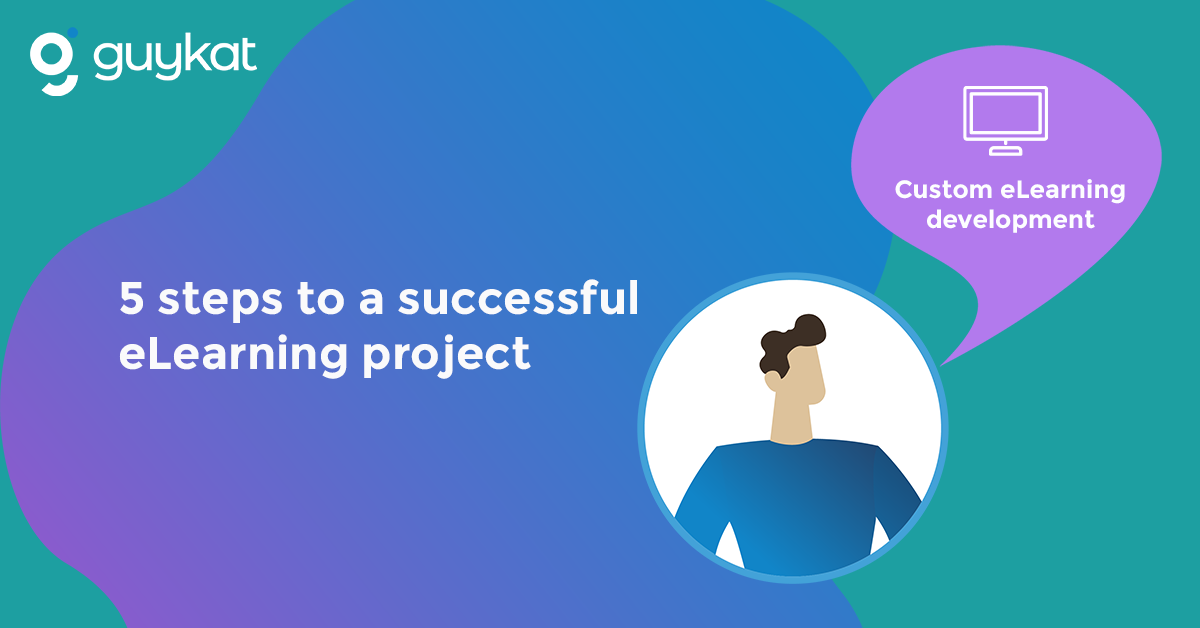At GuyKat we partner with our clients to create online learning experiences. Our development process is based on the ADDIE methodology… with a twist!
The 5 step process is outlined below:
1. Analysis
We start by getting a clear understanding of the client’s use-case and specific requirements. This initial discovery will involve:
- Understanding the vision, what do they want to achieve
- Taking a look at any content the client already has – this doesn’t have to be perfect
- Helping the client understand the possibilities of how the content could be delivered
- Alignment on the delivery, is the module going to have narration, will it be bite-size or a suite of modules
- The sometimes awkward, but necessary conversation about budget and how we fit into that
- And finally, the timelines for delivery
At this stage, we find clients fall into one of two groups:
a. Someone who knows what they want
They might have all, or part of the content ready to be developed, or have the content that needs storyboarding
b. Someone who needs our help to figure out what they want
They need help in developing everything from scratch
Before we get started, it’s important to align expectations about the clients’ quality ambition versus budget. To help frame this conversation, we mutually agree if we’re working to our Bronze, Silver or Gold development levels. With the development standard agreed, we can begin working on the storyboard.
GuyKat tip: It’s tempting for subject matter experts to want to share EVERYTHING they know into a module. Avoid overwhelming your audience. Only share what is necessary to achieve the learning objective. This also helps keep learning bitesize and helps with completion rates.
2. Design
Storyboarding
A storyboard is an outline of the final module. It is a sequence of drawings, typically with some directions and dialogue, representing the shots planned for an eLearning module production.
If our instructional designers are writing the content, then storyboarding is the next step (if the client is providing the scripts/storyboards ready written, we skip this step).
Typically, we get PowerPoints from clients as a starting point. It might be a deck from when they taught the same topic in a physical classroom, or it may be something they’ve put together to help our team understand the subject. Our team works with this input material and shapes it into a proper storyboard for our developers to work on.
Storyboarding includes:
- If it is an audio led module, it will include a script of everything that’s going to be narrated
- Developer notes (such as drag and drop explanations around activities)
- The development of concept art (mockups of the modules)
GuyKat tip: We always encourage our clients to include learning objectives. Sometimes they are explicitly referenced in the content e.g. you may have a screen that tells the learner “By the end of the module you will be able to explain the procurement process”. Sometimes, you may not want to be so explicit to the learner. Either way, you need to make sure that every part of the storyboard is supporting delivering a learning objective, else why is it there?
The first draft sent to the client.
At this stage, the subject matter expert of the client’s internal team will review the storyboard and leave notes as well as comments of what they like/dislike. This is a key part of the QA process. It is much easier, quicker and cheaper to make changes to a storyboard in PowerPoint, than make changes to a developed module. The feedback on comments can be done over email or call (client’s preference). However, in most cases, it’s always more beneficial to discuss it over a call.
GuyKat tip: Ask, ask and ask questions. Also, make suggestions and let us know what you do and don’t like.
Storyboard phase 2
A storyboarding expert works on the storyboard taking into account all of the comments and feedback received from a client. This once again goes back to the client, to check if they’re happy with it going to the development stage.
3. Development
Buildout
The final version of the storyboard is sent off to the eLearning developer. This is as straightforward as it can be – the start of the development!
Internal QA
GuyKat has an internal QA process that takes place before anything goes back to the client.
4. Implementation
Client review
We like to offer 2 rounds of review for the client without any incremental costs. The first draft of the module will be sent in the Articulate review site. The client will be able to go through the module and make comments, suggestions and highlight the things they like.
GuyKat tip: Always let your account manager know you finished reviewing!
The official sign off
Once the client is happy with the final result – we’re happy to wrap up the project. And hopefully, start the new one!
5. Evaluation
Client feedback
Capture any client feedback to ensure the module has met the client’s needs. To achieve that, we send out a Project Feedback survey to the client.
Internal feedback
Arrange Project Closing meeting with internal employees that were involved in the project.


